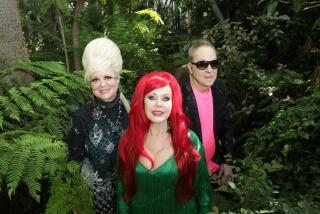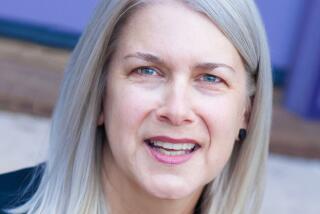The beautiful Airstream myth and painful RV reality of life on the road
- Share via
“You have taken over the job of creating desire, and have transformed people into constantly moving happiness machines. Machines which have become the key to economic progress.” So said the secretary of commerce and next president, Herbert Hoover, to a group of PR men in 1928, after America’s decade of revolutionary consumerism.
“Constantly moving happiness machines” is an apt description of the Airstream dwellers presented in Karen Flett’s recent book, “Living the Airstream Life.” In 160 full-color pages of interviews, guidance and — most enticingly — photographs of dreamy Airstream interiors, Flett lays out the brand’s vision of American freedom, a call to the wandering spirit. “We don’t sell trailers,” Flett quotes Airstream founder Wally Byam in the opening pages, “we sell a way of life.”
This school of sales was invented by Sigmund Freud’s nephew Edward Bernays, the “father of PR” (foremost among those addressed by Hoover in 1928) and an engine of early consumerism. Bernays drew on his uncle’s work to sell products by appealing to humans’ innermost desires — for freedom, for instance; for a certain way of life. Next he set his sights on restructuring American democracy itself. In Bernays’ view, humans were irrational and highly manipulable, making true democracy dangerous. His ideal was to hold up the illusion of democratic empowerment while curbing democratic impulses through a voracious cycle of consumerism that would pique and then sate people’s desires.
Under this consumerist vision of democracy, freedom is a brand to be bought, rather than a natural state or one to be achieved by active engagement in civic affairs. The Airstream that Flett so uncritically presents is the ultimate brand of this bought freedom.
Messaging like this is insidious. Presented with all these pictures of beautiful trailers in majestic settings, it’s easy to fall for the narrative that you can buy freedom. I know how easy it is: I’m a former Airstream dweller. And I was repeatedly flummoxed by Flett’s assertions about the economics of Airstream life. “Less of your finances invested in your home and more efficient use of the income that you do have can lead to a life of being debt-free,” Flett posits, only to later glorify the most expensive ways to live nomadically. “If you have the finances to cover it, getting a professional to be part of the project [of renovating a trailer] is ideal,” she writes, amid page upon page of beautiful interior shots and free advertising for the featured designers. Of course, these designers “charge a pretty penny,” she adds. Airstreams are already more expensive than most RVs and trailers. What other freedoms might a person sacrifice in pursuit of this high-end version of liberty? To her credit (though in conflict with her message about money-saving), Flett cautions against ambitious DIY Airstream renovations, a message I wish I’d heard before embarking on my own, which swallowed time and money and left me in debt – the best lesson I could have had in the wrongheadedness of freedom via spending.
Then there’s the question of living expenses. Flett calculates that “the majority of full-timers live comfortably on about $25,000 a year (plus any trailer or vehicle repayments).” That’s $25,000, after taxes, that must be earned without a fixed address. Freelance work is on the rise, but only certain workers can earn this kind of living. Flett’s interviewees are web designers, writers, and other skilled professionals. But think of a full-time Uber driver taking home $11.21/hour in Denver (the most lucrative of three cities surveyed), who would make $23,317 after tax — and have very little time to “live the Airstream life.” This particular brand of freedom, then, is available only to those who already enjoy a certain degree of economic and social freedom.
Flett herself inadvertently hints at the inaccessibility of the dream. In a throwaway suggestion, she offers “workamping” as a way to make your $25,000 a year. What is workamping? Here is a vision of dystopia for you, via Jessica Bruder’s compelling, deeply researched and alarming “Nomadland: Surviving America in the Twenty-First Century”: During peak seasons, Amazon hires legions of temporary staff to operate its warehouses under a program called CamperForce. CamperForce workers are overwhelmingly senior citizens who cannot afford to retire, people who have moved into RVs and travel from job to job.
Over the course of three years and 15,000 miles, journalist Bruder embedded herself in America’s swelling community of nomads — not Flett’s hip Airstreamers but the full-time inhabitants of cheaper vans, RVs and cars found in cities and open spaces around the country. The book centers on the experiences of the charismatic 64-year-old Linda May, who embarked on the nomadic lifestyle after a lifetime of hard work that won her zero economic freedom. Linda lives in a tiny, rickety trailer she calls the Squeeze Inn and makes her money workamping. She’s an upbeat and appealing companion as Bruder buys her own van, makes repeat visits to an annual nomad meetup and works stints at Amazon and the sugar beet harvest.
Many of the workampers Bruder meets would once have belonged to the middle class: Their former professions include accountant, McDonald’s executive, advertising art director and broadcast journalist, as well as jobs in the retail and service industries. “Sometimes I felt like I was wandering around post-recession refugee camps,” she writes. She meets victims of bad investments and people who hadn’t been able to set aside enough of a safety net to survive divorce, illness, or injury. Most frequently, she meets victims of the 2008 recession, people who were laid off or saw their 401(k)s and other assets wiped out. “Many hoped life on the road would be an escape from an otherwise empty future,” she writes.
Yet the temporary workamping jobs they found are often physically punishing and poorly paid, with no benefits except a free place to park your RV. A CamperForce employee might walk more than 15 miles a day on concrete floors, ceaselessly squatting and bending. Dispensers dotted around the warehouses dole out free painkillers, and an on-site medical team deals with more serious afflictions. Other workamping jobs include working the sugar beet harvest in Montana, Minnesota and North Dakota and campsite hosting, a job that offers pretty camping in exchange for low pay and plenty of toilets to clean. Even with a free parking spot thrown in, most of the workampers Bruder meets struggle to make ends meet. She writes of one of Linda’s stints as a campsite host: “Even if Linda convinced her employer to give her full-time, forty-hour weeks all year long – and didn’t take any vacations – her annual salary would amount to $17,680, with no benefits.”
“Nomadland” is strongest when considering the possibility of choice in late-capitalist America. The nomads Bruder meets distinguish themselves sharply from the simply homeless, stressing that they have chosen this way of life. Bob Wells, a van-dwelling guru, “suggests van-dwellers are conscientious objectors from a broken, corrupting social order.” “No matter how narrow the options one had to pick from, choice was key,” Bruder observes. And yet everyone she meets has been squeezed out of mainstream life by necessity, and many of these conscientious objectors are forced to sell months of their lives to the consumerist system – doing physically punishing work at Amazon’s warehouses – even as they try to opt out of it. Poignantly, when nomad LaVonne’s van breaks down, destroying her precarious finances, she writes on her blog: “You realize you have joined the growing club of people who live on the streets, and there is not so much difference between the two of you after all.” This subculture is marked by its resilience and clear-sightedness about social ills, but their stories suggest there’s no true escape from these ills.
The great trick of democracy hijacked by consumerist capitalism is to give the illusion of choice (so many pretty things to buy!), thus obscuring our essential choicelessness in determining the kind of society we inhabit. Where Karen Flett enacts this trick, Jessica Bruder shows its endgame and the battle being quietly waged against it in vans and RVs around the nation.
Robins is a writer and translator who lives in Los Angeles.
by Karen Flett
Harper Design: 160 pp., $35
“Nomadland: Surviving America in the Twenty-First Century”
by Jessica Bruder
W.W. Norton: 320 pp., $26.95
More to Read
Sign up for our Book Club newsletter
Get the latest news, events and more from the Los Angeles Times Book Club, and help us get L.A. reading and talking.
You may occasionally receive promotional content from the Los Angeles Times.









